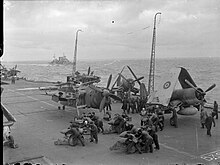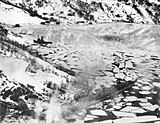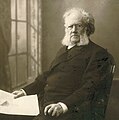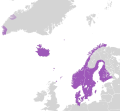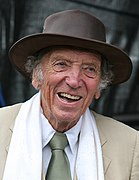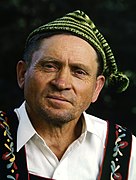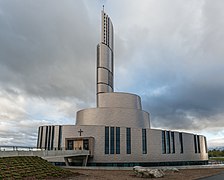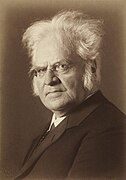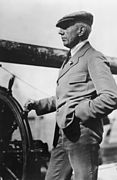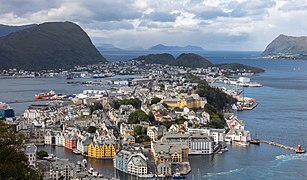Portal:Norway
Portal maintenance status: (September 2019)
automated editing software. Learn how to update the maintenance information here . |
The Norway Portal
Norge Portal

|

|

| |
Norway has a total area of 385,207 square kilometres (148,729 sq mi) and had a population of 5,488,984 in January 2023. The country shares a long eastern border with Sweden. It is bordered by Finland and Russia to the northeast and the Skagerrak strait to the south. Norway has an extensive coastline facing the North Atlantic Ocean and the Barents Sea. Harald V of the House of Glücksburg is the current King of Norway. Jonas Gahr Støre has been Prime Minister of Norway since 2021. As a unitary state with a constitutional monarchy, Norway divides state power between the parliament, the cabinet, and the supreme court, as determined by the 1814 constitution. The unified kingdom of Norway was established in 872 as a merger of petty kingdoms and has existed continuously for 1151–1152 years. From 1537 to 1814, Norway was part of Denmark–Norway, and, from 1814 to 1905, it was in a personal union with Sweden. Norway was neutral during the First World War, and in the Second World War until April 1940 when it was invaded and occupied by Nazi Germany until the end of the war.
Norway maintains the Nordic welfare model with universal health care and a comprehensive social security system, and its values are rooted in egalitarian ideals. The Norwegian state has large ownership positions in key industrial sectors, having extensive reserves of petroleum, natural gas, minerals, lumber, seafood, and fresh water. The petroleum industry accounts for around a quarter of the country's gross domestic product (GDP). On a per-capita basis, Norway is the world's largest producer of oil and natural gas outside of the Middle East. The country has the fourth- and eight highest per-capita income in the world on the World Bank's and IMF's list, respectively. It has the world's largest sovereign wealth fund, with a value of US$1.3 trillion. (Full article...)
 Featured article – show another
Featured article – show another
-
Image 1sister species, although this is debated. In a study that used mitochondrial and nuclear intron DNA, the black-throated loon was found to be sister to a clade consisting of the Pacific loon and two sister species, the common loon and the yellow-billed loon.)
The black-throated loon measures about 70 cm (28 in) in length and can weigh anywhere from 1.3 to 3.4 kilograms (2.9 to 7.5 lb). In breeding plumage, the adult of the nominate subspecies has mostly black upperparts, with the exception of some of the mantle and scapulars, which have white squares. The head and hindneck are grey, and the sides white and striped black. Most of the throat is also black, giving this bird the name "black-throated loon". The colour of the throat patch can be used to distinguish the two subspecies; the throat patch of the other subspecies, G. a. viridigularis, is green. The underparts are mostly white, including the bottom of the throat. The flanks are also white, a feature which can be used to separate this bird from the Pacific loon. When it is not breeding, the black patch on the throat is absent, replaced with white; most of the black lines on the throat are also missing, except those on the bottom sides, and the upperparts are unpatterned with the exception of a few white spots on the upperwing. The juvenile is similar to the non-breeding adult, except more brown overall. (Full article... -
Image 2Geographic South Pole was led by the Norwegian explorer Roald Amundsen. Himself and four other crew members made it to the geographical south pole on 14 December 1911, which would prove to be five weeks ahead of the competetive British party led by Robert Falcon Scott as part of the Terra Nova Expedition. Amundsen and his team returned safely to their base, and about a year later heard that Scott and his four companions had perished on their return journey.)
Amundsen's initial plans had focused on the Arctic and the conquest of the North Pole by means of an extended drift in an icebound ship. He obtained the use of Fridtjof Nansen's polar exploration ship Fram, and undertook extensive fundraising. Preparations for this expedition were disrupted when, in 1909, the rival American explorers Frederick Cook and Robert Peary each claimed to have reached the North Pole. Amundsen then changed his plan and began to prepare for a conquest of the South Pole; uncertain of the extent to which the public and his backers would support him, he kept this revised objective secret. When he set out in June 1910, he led even his crew to believe they were embarking on an Arctic drift, and revealed their true Antarctic destination only when Fram was leaving their last port of call, Madeira. (Full article...Image 3
On 9 February 1945, a force of Allied Bristol Beaufighter aircraft suffered many losses during an attack on the German destroyer Z33 and its escorting vessels; the operation was called Black Friday by the survivors. The German ships were sheltering in a strong defensive position in Førde Fjord, Norway, forcing the Allied aircraft to attack through massed anti-aircraft fire (FlaK).
The Beaufighters and their escort of Mustang Mk III fighters from 65 Squadron RAF were intercepted by twelve Focke-Wulf Fw 190s of Jagdgeschwader 5 (Fighter Wing 5) of the Luftwaffe. The Allies damaged at least two of the German ships for the loss of seven Beaufighters shot down by FlaK. Two Beaufighters and a Mustang were shot down by the Fw 190s and four or five of the German aircraft were shot down by the Allied aircraft, including that of the ace Rudi Linz. (Full article...)Image 4feminist writer Mary Wollstonecraft. The twenty-five letters cover a wide range of topics, from sociological reflections on Scandinavia and its peoples to philosophical questions regarding identity. Published by Wollstonecraft's career-long publisher, Joseph Johnson, it was the last work issued during her lifetime.)
Wollstonecraft undertook her tour of Sweden, Norway, and Denmark in order to retrieve a stolen treasure ship for her lover, Gilbert Imlay. Believing that the journey would restore their strained relationship, she eagerly set off. However, over the course of the three months she spent in Scandinavia, she realized that Imlay had no intention of renewing the relationship. The letters, which constitute the text, drawn from her journal and from missives she sent to Imlay, reflect her anger and melancholy over his repeated betrayals. Letters Written in Sweden, Norway, and Denmark is therefore both a travel narrative and an autobiographical memoir. (Full article...Image 5cross-country skis. He won international fame after reaching a record northern latitude of 86°14′ during his Fram expedition of 1893–1896. Although he retired from exploration after his return to Norway, his techniques of polar travel and his innovations in equipment and clothing influenced a generation of subsequent Arctic and Antarctic expeditions. He was elected an International Member of the American Philosophical Society in 1897. (Full article...)Image 6Corsair fighters and Barracuda bombers ranged on the flight deck of HMS Formidable during operations off Norway in July 1944
Operation Mascot was an unsuccessful British carrier air raid conducted against the German battleship Tirpitz at her anchorage in Kaafjord, Norway, on 17 July 1944. The attack was one of a series of strikes against the battleship launched from aircraft carriers between April and August 1944, and was initiated after Allied intelligence determined that the damage inflicted during the Operation Tungsten raid on 3 April had been repaired.
A force of 44 British dive bombers and 40 fighters took off from three aircraft carriers in the early hours of 17 July. German radar stations detected these aircraft while they were en route to Kaafjord, and Tirpitz was protected by a smoke screen by the time the strike force arrived. Few of the British airmen were able to spot the battleship, and their attacks did not inflict any significant damage. German losses were limited to a patrol craft, and three British aircraft were destroyed or damaged beyond repair by Kaafjord's defenders. A group of German submarines attempted to intercept the carrier force as it returned to base, without success. Two U-boats were sunk near the carriers by British patrol aircraft and several others were damaged. (Full article...)Image 7Queen of Bohemia; and James's future successor, Charles I. Anne demonstrated an independent streak and a willingness to use factional Scottish politics in her conflicts with James over the custody of Prince Henry and his treatment of her friend Beatrix Ruthven. Anne appears to have loved James at first, but the couple gradually drifted and eventually lived apart, though mutual respect and a degree of affection survived. (Full article...)Image 8"certified gold in the US and Australia and remained M2M's biggest hit. M2M performed the song on episodes of the television series One World, Top of the Pops and Disney Channel in Concert. Two similar music videos were released for the song, with one showing clips from Pokémon: The First Movie. (Full article...)Image 9Great Ice Barrier since the expedition of Sir James Clark Ross nearly sixty years earlier. (Full article...)Image 10matrilineal family groups (pods). Their sophisticated hunting techniques and vocal behaviors, often specific to a particular group and passed along from generation to generation are considered to be manifestations of animal culture. (Full article...)Image 11hydrogen balloon from Svalbard to either Russia or Canada, which was to pass, with luck, straight over the North Pole on the way. The scheme was received with patriotic enthusiasm in Sweden, a northern nation that had fallen behind in the race for the North Pole.)
Andrée ignored many early signs of the dangers associated with his balloon plan. Being able to steer the balloon to some extent was essential for a safe journey, but there was much evidence that the drag-rope steering technique he had invented was ineffective. Worse, the polar balloon Örnen (Eagle) was delivered directly to Svalbard from its manufacturer in Paris without being tested. When measurements showed it to be leaking more than expected, Andrée failed to acknowledge the risk. (Full article...Image 12Barracuda bombers and Corsair fighters being armed on the flight deck of HMS Formidable during Operation Goodwood
Operation Goodwood was a series of British carrier air raids conducted against the German battleship Tirpitz at her anchorage in Kaafjord in occupied Norway during late August 1944. It was the last of several attacks made by the Home Fleet during 1944 which sought to damage or sink Tirpitz and thereby eliminate the threat it posed to Allied shipping. Previous raids on Kaafjord conducted by Fleet Air Arm aircraft had involved only one air attack; in Operation Goodwood several attacks were made in a single week. The Royal Navy hoped that these raids would wear down the formidable German defences.
The British fleet departed its base on 18 August and launched the first raid against Kaafjord on the morning of 22 August. The attack failed, and a small raid that evening inflicted little damage. Attacks were conducted on 24 and 29 August and were also failures. Tirpitz had been hit by two bombs during the raid on 24 August, but neither caused significant damage. British losses during Operation Goodwood were 17 aircraft to all causes, a frigate sunk by a submarine, and an escort carrier badly damaged. German forces suffered the loss of 12 aircraft and damage to 7 ships. (Full article...)Image 13sexually dimorphic, as adult females are much smaller. The polar bear is white- or yellowish-furred with black skin and a thick layer of fat. It is more slender than the brown bear, with a narrower skull, longer neck and lower shoulder hump. Its teeth are sharper and more adapted to cutting meat. The paws are large and allow the bear to walk on ice and paddle in the water.)
Polar bears are both terrestrial and pagophilic (ice-living) and are considered to be marine mammals due to their dependence on marine ecosystems. They prefer the annual sea ice but live on land when the ice melts in the summer. They are mostly carnivorous and specialized for preying on seals, particularly ringed seals. Such prey is typically taken by ambush; the bear may stalk its prey on the ice or in the water, but also will stay at a breathing hole or ice edge to wait for prey to swim by. The bear primarily feeds on the seal's energy-rich blubber. Other prey include walruses, beluga whales and some terrestrial animals. Polar bears are usually solitary but can be found in groups when on land. During the breeding season, male bears guard females and defend them from rivals. Mothers give birth to cubs in maternity dens during the winter. Young stay with their mother for up to two and a half years. (Full article...Image 14In September 1967, Denmark, Norway, Sweden and the Netherlands brought thestaged a military coup that ousted the Greek government and used mass arrests, purges and censorship to suppress their opposition. These tactics soon became the target of criticism in the Parliamentary Assembly of the Council of Europe, but Greece claimed they were necessary as a response to alleged Communist subversion and justified under Article 15 of the ECHR. In September 1967, Denmark, Norway, Sweden, and the Netherlands filed identical cases against Greece alleging violations of most of the articles in the ECHR that protect individual rights. The case was declared admissible in January 1968; a second case filed by Denmark, Norway and Sweden for additional violations, especially of Article 3 forbidding torture, was declared admissible in May of that year. (Full article...)Image 15Russian famine of 1921 in Povolzhye. He was posted as a Norwegian diplomat to the Soviet Union and for some time also managed British diplomatic affairs there. He returned to Norway in 1929 and served as minister of defence in the governments of Peder Kolstad (1931–32) and Jens Hundseid (1932–33) in representing the Farmers' Party. (Full article...)Image 16Bosse as Indra's daughter at the 1907 première of A Dream Play (1902) by August Strindberg
Harriet Sofie Bosse (19 February 1878 – 2 November 1961) was a Swedish–Norwegian actress. A celebrity in her day, Bosse is now most commonly remembered as the third wife of the playwright August Strindberg. Bosse began her career in a minor company run by her forceful older sister Alma Fahlstrøm in Kristiania (now Oslo, the capital of Norway). Having secured an engagement at the Royal Dramatic Theatre, the main drama venue of Sweden's capital Stockholm, Bosse caught the attention of Strindberg with her intelligent acting and exotic "oriental" appearance.
After a whirlwind courtship, which unfolds in detail in Strindberg's letters and diary, Strindberg and Bosse were married in 1901, when he was 52 and she 23. Strindberg wrote a number of major roles for Bosse during their short and stormy relationship, especially in 1900–01, a period of great creativity and productivity for him. Like his previous two marriages, the relationship failed as a result of Strindberg's jealousy, which some biographers have characterized as paranoid. (Full article...)Image 17pack ice, and waited for the drift to carry her towards the pole. Impatient with the slow speed and erratic character of the drift, after 18 months Nansen and a chosen companion, Hjalmar Johansen, left the ship with a team of Samoyed dogs and sledges and made for the pole. They did not reach it, but they achieved a record Farthest North latitude of 86°13.6′N before a long retreat over ice and water to reach safety in Franz Josef Land. Meanwhile, Fram continued to drift westward, finally emerging in the North Atlantic Ocean.)
The idea for the expedition had arisen after items from the American vessel Jeannette, which had sunk off the north coast of Siberia in 1881, were discovered three years later off the south-west coast of Greenland. The wreckage had obviously been carried across the polar ocean, perhaps across the pole itself. Based on this and other debris recovered from the Greenland coast, the meteorologist Henrik Mohn developed a theory of transpolar drift, which led Nansen to believe that a specially designed ship could be frozen in the pack ice and follow the same track as Jeannette wreckage, thus reaching the vicinity of the pole. (Full article...Image 18Swaziland. He boxed for South Africa at the 1934 Empire Games. After being turned down by the South African Air Force because he did not speak Afrikaans, he joined the RAF and, on becoming a pilot officer in August 1936, mustered into No. 43 Squadron at RAF Tangmere in Sussex.)
A skilful pilot, Hull dedicated much of his pre-war service to aerobatics, flying Hawker Audaxes, Furies and Hurricanes. He reacted to the outbreak of war with enthusiasm and achieved No. 43 Squadron's first victory of the conflict in late January 1940. Reassigned to Norway in May 1940 to command a flight of Gloster Gladiator biplanes belonging to No. 263 Squadron, he downed four German aircraft in an hour over the Bodø area south-west of Narvik on 26 May, a feat that earned him the Distinguished Flying Cross. He was shot down the next day, and invalided back to England. Hull returned to action at the end of August, when he was made commander of No. 43 Squadron with the rank of squadron leader. A week later, he died in a dogfight over south London. (Full article...Image 19explorations of North America. (Full article...)Image 20A Fleet Air Arm crewman chalks a message on the 1,600-pound bomb carried by a Fairey Barracuda of HMS Furious
Operation Tungsten was a Second World War Royal Navy air raid that targeted the German battleship Tirpitz. The operation sought to damage or destroy Tirpitz at her base in Kaafjord in the far north of Norway before she could become fully operational again following a period of repairs.
The British decision to strike Kaafjord was motivated by fears that the battleship, upon re-entering service, would attack strategically important convoys carrying supplies to the Soviet Union. Removing the threat posed by Tirpitz would also allow the Allies to redeploy the capital ships which had to be held in the North Sea to counter her. After four months of training and preparations, the British Home Fleet sailed on 30 March 1944 and aircraft launched from five aircraft carriers struck Kaafjord on 3 April. The raid achieved surprise, and the British aircraft met little opposition. Fifteen bombs hit the battleship, and strafing by fighter aircraft inflicted heavy casualties on her gun crews. Four British aircraft and nine airmen were lost during the operation. (Full article...)Image 21TheNynorsk: Dei 6. olympiske vinterleikane) and commonly known as Oslo 1952, was a winter multi-sport event held from 14 to 25 February 1952 in Oslo, the capital of Norway.)
Discussions about Oslo hosting the Winter Olympic Games began as early as 1935; the city was keen to host the 1948 Winter Olympics, but that was made impossible by World War II. Instead, Oslo won the right to host the 1952 Games in a contest that included Cortina d'Ampezzo in Italy and Lake Placid in the United States. All of the Olympic venues were in Oslo's metropolitan area, except for the alpine skiing events, which were held at Norefjell, 113 km (70 mi) from the capital. A new hotel was built for the press and dignitaries, along with three dormitories to house athletes and coaches, creating the first modern athlete's village. Oslo bore the financial burden of hosting the Games in return for the revenue they generated. The 1952 Winter Olympics was the first of the two consecutive Olympics to be held in Northern Europe, preceding the 1952 Summer Olympics in Helsinki, Finland. (Full article...Image 22{{/box-footer|German-occupied Norway. The attack was conducted on 15 September 1944 by 21 Royal Air Force heavy bombers, which flew from an airfield in the north of the Soviet Union. The battleship was struck by one bomb, and further damaged by several near misses. This damage rendered Tirpitz unfit for combat, and she could not be repaired as it was no longer possible for the Germans to sail her to a major port.)
The attack on 15 September followed a series of raids conducted against Tirpitz with limited success by Royal Navy carrier aircraft between April and August 1944, seeking to sink or disable the battleship at her anchorage, so that she no longer posed a threat to Allied convoys travelling to and from the Soviet Union. The first of these raids was successful, but the other attacks failed due to shortcomings with the Fleet Air Arm's strike aircraft and the formidable German defences. As a result, the task of attacking the battleship was transferred to the RAF's Bomber Command. Avro Lancaster bombers from the Command's two elite squadrons flew to their staging airfield in the Soviet Union on the night of 11/12 September, and attacked on 15 September using heavy bombs and air-dropped mines. All of the British aircraft returned to base, though one of the Lancasters later crashed during its flight back to the United Kingdom. (Full article...Image 23Captain James Cook's crossing of the Antarctic Circle in 1773, and the earliest confirmed sightings of the Antarctic mainland in 1820. From the late 19th century onward, the quest for Farthest South latitudes became a race to reach the pole, which culminated in Roald Amundsen's success in December 1911. (Full article...)Selected article – show another
In the "Førde Fjord, Norway, forcing the Allied aircraft to attack through heavy anti-aircraft fire. The Beaufighters and their escort of North American P-51 Mustang fighters were also surprised by twelve German Focke-Wulf Fw 190 fighters. In the resulting attack the Allies damaged at least two of the German ships for the loss of seven Beaufighters shot down by flak guns. Another two Beaufighters and one Mustang were destroyed by the Fw 190s. Either four or five German fighters were shot down by the Allied aircraft, including one flown by an ace. Due to the losses suffered in this raid the Allied anti-shipping force adopted new tactics which placed a lower priority on attacking warships. (Full article...)Selected picture – show another
Photograph credit: Simo RäsänenReine is a fishing village located on the island of Moskenesøya in the Lofoten archipelago in northern Norway, serving as the administrative centre for the municipality of Moskenes, Nordland. A trading post was established here in 1743, and the village was a centre for the local fishing industry, with a fleet of boats and facilities for fish processing and marketing. In December 1941, part of Reine was burnt by the Germans in reprisal for Operation Anklet, a raid on the islands of Lofoten by British troops, who occupied the area for two days before withdrawing because of lack of air support.In this month
- Andreas Thorkildsen (born 1 April 1982 in Kristiansand) is a Norwegian javelin thrower.
- Gro Harlem Brundtland (pictured) (born 20 April 1939) is a Norwegian politician, diplomat and physician, and an international leader in sustainable development and public health. She is a former Prime Minister of Norway, and has served as the Director General of the World Health Organization.
- The Battle of Dombås was fought between Norwegian Army infantry forces and German Fallschirmjäger paratroops in mid-April 1940.
- Christian Democratic Party. He was Prime Minister of Norway from 1972 to 1973, leading the cabinet that took over when Trygve Bratteli resigned in the wake of the first referendum over Norway's membership in the European Economic Community.
General images – show another
The following are images from various Norway-related articles on Wikipedia.-
Image 1Battle of Alvøen between the frigate HMS Tartar and Norwegian gunboats near Bergen in 1808 (from History of Norway)
-
Image 5Homann's map of the Scandinavian Peninsula and Fennoscandia with their surrounding territories: northern Germany, northern Poland, the Baltic region, Livonia, Belarus, and parts of Northwest Russia. Johann Baptist Homann (1664–1724) was a German geographer and cartographer; map dated around 1730. (from History of Norway)
-
Image 6Map of Sweden–Norway (from History of Norway)
-
Image 7Traditional Norwegian St. Hansbål (midsummer) bonfire in Laksevåg, Bergen (from Culture of Norway)
-
Image 8Bridal Journey in Hardanger (1848) by Adolph Tidemand and Hans Gude, an example of romantic nationalism (from History of Norway)
-
Image 11Map of Denmark–Norway (from History of Norway)
-
Image 14Statfjord oil platform (from History of Norway)
-
Image 15Scenes from theNorwegian Campaign in 1940 (from History of Norway)
-
Image 17Alta Power Station, built despite massive protests (from History of Norway)
-
Image 18Norwegian Prime Minister Kjell Magne Bondevik met with U.S. President George W. Bush at the Oval Office in White House, on 27 May 2003. (from History of Norway)
-
Image 19Edvard Munch's The Scream (1893) (from Culture of Norway)
-
Image 21Roald Amundsen, Helmer Hanssen, Sverre Hassel and Oscar Wisting (l–r) at Polheim, the tent erected at the South Pole on 16 December 1911 as the first expedition (from History of Norway)
-
Image 24Smørbrød, Norwegian open sandwiches (from Culture of Norway)
-
Image 26Bryggen in Bergen, once the centre of trade in Norway under the Hanseatic League trade network, now preserved as a World Heritage Site (from History of Norway)
 Good article – show anotherThis is aGood article, an article that meets a core set of high editorial standards.
Good article – show anotherThis is aGood article, an article that meets a core set of high editorial standards.
-
Image 1Johan Randulf Bull Hambro (24 October 1915 – 27 February 1993) was a Norwegian journalist, translator and biographer. He was the fourth son of Norwegian politician C. J. Hambro, whose biography he wrote in 1984. He lived in the United States from 1939 to 1982, where he studied and worked as a foreign-affairs journalist, press attaché and consulate-general. He was secretary general of the Norse Federation for 27 years, from 1955 to 1982. He was decorated as a Knight, First Class of the Order of St. Olav in 1975. (Full article...)
-
Image 2regenerative brakes and weigh 64 tonnes (63 long tons; 71 short tons). The series was delivered at the same time as the Di 4 and have some similarities with the class. (Full article...)Image 3wet lease operation, in addition to several international destinations from London. Air Europe went bankrupt in March 1991, causing Norway Airlines to temporarily halt operations. (Full article...)Image 4World Women's Handball Championship in 1993 and 1999, the Junior Eurovision Song Contest 2004, the 2008 European Men's Handball Championship and the 2010 European Women's Handball Championship. Lillehammer IK has occasionally played ice hockey matches at the arena. (Full article...)Image 5X2 units. By 2009, all units were expanded with a fourth car. (Full article...)Image 6Værøy Municipality. It was served by Widerøe, who operated de Havilland Canada DHC-6 Twin Otter aircraft to the town of Bodø and the nearby island of Røstlandet. After a fatal accident in 1990, the airport was shut down.)
Widerøe commenced seaplane operates to Værøy from 1965; five years later the first helicopter services were introduced. Planning of an airport started in the late 1960s, but unfavorable weather conditions prolonged finding a suitable location. The decision to build the airport was taken in 1984, construction began the following year and the airport opened on 1 June 1986. The fatal Widerøe Flight 839 accident took place on 12 April 1990, in which heavy wind caused structural failure of a Twin Otter. The airport has been closed since; helicopter services commenced in 1993 and Værøy Heliport opened in 1997. (Full article...Image 7center platform and part of the access way has been built, but never completed. While the station initially was not put into use because of lack of funds to complete it, it is now unlikely that it will ever be completed, as the need for a station has disappeared and an opening would need a large investment of funds. (Full article...)Image 8Thorfinn Sigurdsson. (Full article...)Image 9Anniemal is the debut album by Norwegian singer Annie. It was first released by 679 Recordings in September 2004. Annie began recording music in 1999 with her boyfriend, Tore Kroknes, who died in 2001. She returned to recording later that year, collaborating with Richard X, Röyksopp, and Timo Kaukolampi.
The album combines Annie's thin, airy vocals with heavily layered beats. It is heavily influenced by 1980s dance-pop. Upon release, the album was successful in Norway. Blogs leaked tracks from Anniemal before it was released internationally, and publications from other countries soon praised the album for its blissful but melancholic sound. (Full article...)Image 10electrified Arendal Line. In 2000, a unit was involved in the Åsta accident; which killed 19 people. The trains were refurbished in 2005 and 2006, and NSB plans to replace them by around 2019.[needs update] Each twin unit seats 168 people, is 49.45 meters (162 ft 3 in) long and weighs 92 tonnes (91 long tons; 101 short tons). The front car is powered with two electric motors, giving a power output of 714 kilowatts (957 hp) and a maximum speed of 140 kilometers per hour (87 mph). (Full article...)Image 11Trans Polar A/S was a Norwegian charter airline which operated between June 1970 and May 1971. The airline operated a fleet of three Boeing 720s and had a close cooperation with Aer Lingus for maintenance. Trans Polar was established by Thor Tjøntveit, although he never held any management positions. The airline was headquartered in Oslo, although most of the flights operated out of Copenhagen, Denmark, which was the base of Spies Rejser, Trans Polar's largest customer. The airline held operating permission from Norway and Denmark, but not Sweden; nevertheless, they operated several illegal flights out of Stockholm.
Trans Polar ceased operations on 16 May 1971 when Boeing Commercial Airplanes seized one of their aircraft for failing to pay installments. After the company's bankruptcy on 23 June, the police undertook a seven-year investigation of the company. The airline had operated eight months with insolvency; with a debt of 33 million Norwegian krone (NOK) it was at the time the largest bankruptcy case in Norwegian history. Tjøntveit was acquitted of charges of deceit in 1978. (Full article...)Image 12French police investigated connections between Scientology and Ballo's death, and interviewed two leaders of the Church of Scientology in France; prosecutors stated in December 2008 that they were unable to establish a causative link.)
A Scientology representative in France asserted that the OCA was not created by the Church, and that it was not related to the suicide. Scientology's information chief in Norway, Matthias Fosse, stated that the OCA was not dangerous and that the organization did not bear any responsibility for the tragedy. Ballo's father, Norwegian MP Olav Gunnar Ballo (SV), retained a lawyer to investigate his daughter's death, and her family considered filing a lawsuit against Scientology. 500 people attended Ballo's funeral on April 11, 2008, at Grefsen Church in Oslo. (Full article...Image 13Co′Co′ locomotives, each with a power output of 5,400 kW (7,200 hp). Each operates with 600 kilonewtons (130,000 pounds-force) tractive effort and has a maximum speed of 80 km/h (50 mph). Delivery of the first series of 18 locomotives was made from 2000 to 2004, and they replaced some of the aging Dm3 and El 15 units. In 2007, eight more vehicles (4 double units) were ordered, with production to be completed by 2011, by which time, another four double units were ordered. These units were scheduled to be delivered from 2013 to 2014. (Full article...)Image 14Trunk, Gardermoen and Kongsvinger lines and south of Oslo it follows the Østfold and Eastern Østfold lines. (Full article...)Image 15A/S Bergen Aviation was a Norwegian airline that never operated any scheduled flights. Based in Bergen and established in 1981, it operated 2 Piper Cheyenne 2 turboprop for charter. It was originally established by the Bird Technology Group and was acquired by As Nevi in the Vestagroup in 1983. This was a time when SAS did not service Bergen well except Oslo and Copenhagen further adding to Flesland's decline as an important airport.
Later it signed an agreement to fly charter flights with Vestlandsreiser in 1986. It had also made an unsuccessful attempt to receive concession to operate domestic scheduled flights between Oslo Airport, Fornebu and Bergen Airport, Flesland. The airline bought 2 Sud Aviation Caravelle, but never received permission to operate. One Caravelle was severely damaged under take-off at Arlanda Airport in 1986 and left there for various kind of training for several years. The crash saved Bergen Aviation financially. (Full article...)Image 16Svalbard Airport, Longyear, operated two to four times a week by Lufttransport using Dornier 228 aircraft. The services are organized as corporate charters and tickets are only available after permission from Kings Bay.)
Between 1925 and 1928, Ny-Ålesund saw four air expeditions to the North Pole, two of which required the construction of an airship hangar and mast. The first proposal for an airport in Ny-Ålesund was launched in 1956 by Norsk Polar Navigasjon, who proposed an airport at Kvadehuksletta. Soviet protests against the airport caused the Norwegian authorities to oppose the plans, which were laid to rest in the early 1960s. Construction at Hamnerabben started in 1965 following the decision to build Kongsfjord Telemetry Station. The airport first hosted service to temporary landing strips near Longyearbyen, but from 1975 served Svalbard Airport. Lufttransport started flights with helicopters in the 1980s, but from 1989 has flown with fixed-wing aircraft. (Full article...Image 17Oslo in mainland Norway. Lufttransport provides services to the two other airports on Svalbard: Ny-Ålesund and Svea, using Dornier 228 turboprop aircraft. There are also regular charter flights. (Full article...)Image 18genres of electronic music, the band solidified their place in the electronica scene with their 2001 debut album, Melody A.M., released on the Wall of Sound record label.)
Röyksopp has consistently experimented with various genres pertaining to electronic music. Stylistically, the band makes use of various genres, including ambient, house music and synth-pop. The band is also known for its elaborate concert performances, which often feature eccentric outfits. (Full article...Image 19WorldView, Galileo and CHEOPS. The system is coordinated with Svalbard Satellite Station (SvalSat) in Longyearbyen, Norway, which combined offer downloading twice per orbit. (Full article...)Image 20Norwegian Railway Inspectorate had given dispensation from parts of the safety regulation. On 17 June 2000, a train derailed at Nelaug Station after an axle broke. The class was grounded for a month, and the investigation showed both design errors, and lack of proper inspection and testing. After they were put back into service, they were not allowed to use the tilting mechanism—thus not being allowed to run faster than their predecessors. The construction was reinforced, and in 2004, the tilting mechanism was re-enabled along with higher speeds. In 2007, a train derailed on the Bergen Line, and questions were raised about the trains' ability to operate in snow, however the accident report showed that the trains' front axle load was just as able to cope with heavy snow conditions as the locomotives running on the line, and that the derailment would have been more severe if the same conditions would hit a normal train with less secure connections between carriages. On 16 June 2011, two units were destroyed when the train ran into a fire in a snow tunnel at Hallingskeid Station. (Full article...)Image 21Oslo East Station.)
The Line was built by the Norwegian State Railways (NSB) and opened on 1 December 1909, along with the last part of the Bergen Line. The line was electrified in 1961. Until 1989, nearly all Oslo–Bergen trains used the line to terminate at Oslo East Station. It was also possible to reach Oslo from Hønefoss via the Randsfjord Line, albeit terminating at Oslo West Station. NSB also ran a local service between Hønefoss and Oslo along the Roa–Hønefoss Line. Oslo–Bergen trains ran via the Randsfjord Line after 1989 and local train services have been terminated. However, the line remains in use for freight trains along the Oslo–Bergen route. (Full article...Image 22SJ Norge serves the station with express trains to Oslo and Bodø, regional trains to Røros and Östersund in Sweden, and the Trøndelag Commuter Rail. The Trondheim Bus Station located at the station serves all long-distance buses, and some city buses. From 1913 to 1968 the station was also the terminus for two lines of the Trondheim Tramway. (Full article...)Image 232022 Russian invasion of Ukraine, the Progress Party has been amenable to receiving Ukrainian refugees. (Full article...)Image 24N.V. and Fjord Seafood. The group is headquartered in Bergen and is listed on the Oslo Stock Exchange where it is a constituent of the benchmark OBX Index. (Full article...)Image 25prosecution. The directorate is led by National Police Commissioner Odd Reidar Humlegård.)
Each police district is led by a chief of police and is subdivided into several police stations in towns and cities, and sheriffs' offices for rural areas. The Governor of Svalbard acts as chief of police for Svalbard. Norwegian police officers do not carry firearms, but keep their Heckler & Koch MP5 submachine guns and Heckler & Koch P30 pistols locked down in the patrol cars. The Norwegian Prosecuting Authority is partially integrated with the police. (Full article...Selected biography – show another
drama. He is often referred to as the "father of modern drama." His plays were considered scandalous to many of his era, when Victorian values of family life and propriety largely held sway in Europe and any challenge to them was considered immoral and outrageous. Ibsen's work examined the realities that lay behind many facades, possessing a revelatory nature that was disquieting to many contemporaries. Ibsen largely founded the modern stage by introducing a critical eye and free inquiry into the conditions of life and issues of morality. Victorian-era plays were expected to be moral dramas with noble protagonists pitted against darker forces; every drama was expected to result in a morally appropriate conclusion, meaning that goodness was to bring happiness, and immorality pain. Ibsen challenged this notion and the beliefs of his times and shattered the illusions of his audiences. (Full article...)Did you know – show different entries
- ...that following the German invasion of Norway, General Fleischer (pictured) and County Governor Hans Gabrielsen assumed all military and civilian power in Northern Norway, declaring the region a theatre of war?
- ...that Film & Kino, which organizes municipal-owned cinemas in Norway, also co-organizes the Norwegian International Film Festival in Haugesund?
- ...that Englishman Royal Norwegian Order of Saint Olav for his eight-volume work Oxford Ibsen?
Selected quote – show another
One of the qualities of liberty is that, as long as it is being striven after, it goes on expanding. Therefore, the man who stands in the midst of the struggle and says, "I have it," merely shows by doing so that he has just lost it. Categories
Selected panorama
Main topics
Counties: • Agder • Innlandet • Møre og Romsdal • Nordland • Oslo • Rogaland • Troms og Finnmark • Trøndelag • Vestfold og Telemark • Vestland • Viken (county)
Constitution Day• Cuisine • Farm culture •Jul• Literature • Music • CinemaHistory: Ancient Norwegian property laws • Nordic Stone Age • Nordic Bronze Age •
Komsa•Fosna-Hensbacka culture• Funnelbeaker culture • Hamburg culture • Nøstvet and Lihult cultures • Maglemosian culture • Viking Age •Harald I of Norway•Olav IV of Norway•Haakon I of Norway•Olaf I of Norway• Olaf II of Norway • Battle of Stiklestad •Canute the Great•Magnus I of Norway•Harald III of Norway• Battle of Stamford Bridge •Magnus III of Norway•Sigurd I of Norway• Magnus V of Norway • Sverre of Norway •Haakon IV of Norway•Magnus VI of Norway• Eric II of Norway • Kalmar Union • Denmark–Norway • Union between Sweden and Norway • Dissolution of the union between Norway and Sweden in 1905 •Haakon VII of Norway•Olav V of Norway•Harald V of Norway•Occupation of Norway by Nazi Germany•Norwegian Campaign• Norwegian resistance movement • Legal purge in Norway after World War II • Foreign relations of Norway •Military of Norway• Norway and the European UnionLanguage: Å • Æ • Ø • Bokmål •
Det Norske Akademi for Sprog og Litteratur•Differences between Norwegian Bokmål and Standard Danish• Høgnorsk • Nordic Council • Nordic Language Convention • Noregs Mållag • Norsk Ordbok • North Germanic languages •Norwegian alphabet• Norwegian dialects •Norwegian Language Council• Norwegian language conflict • Norwegian phonology • Nynorsk • Old Norse •Riksmålsforbundet• RussenorskPolitics: Constitution • Counties (Fylker) • Elections • European Union relations • Foreign relations • Government • Monarchy • Municipalities (Kommuner) • Political parties • Prime Minister • Norwegian nationalism • Romantic nationalism •
Sámi Parliament• StortingFeatured and Good content
Related portals
WikiProjects
- Parent projects
WikiProject Countries • WikiProject Europe
- Main project
- Similar projects
WikiProject Denmark • WikiProject Finland • WikiProject Iceland • WikiProject Sweden • WikiProject Russia
What are WikiProjects?
Things you can do
- Add {{Portal|Norway}} to existing See also sectionsof Norway-related articles.
- Tag the talk pages of Norway-related articles with the {{WikiProject Norway}} banner.
- Norway WikiProject.
- Requested Norway-related articles
- Expand stubs: Building and structure stubs, Company stubs, Nordic football club stubs, Geography stubs, History stubs, Musical group stubs, People stubs, All Norway stub articles
- Note: For additional tasks, see - Wikipedia talk:WikiProject Norway/to do
Associated Wikimedia
The following Wikimedia Foundation sister projects provide more on this subject:
-
Commons
Free media repository -
Wikibooks
Free textbooks and manuals -
Wikidata
Free knowledge base -
Wikinews
Free-content news -
Wikiquote
Collection of quotations -
Wikisource
Free-content library -
Wikiversity
Free learning tools -
Wikivoyage
Free travel guide -
Wiktionary
Dictionary and thesaurus
Discover Wikipedia using portals




